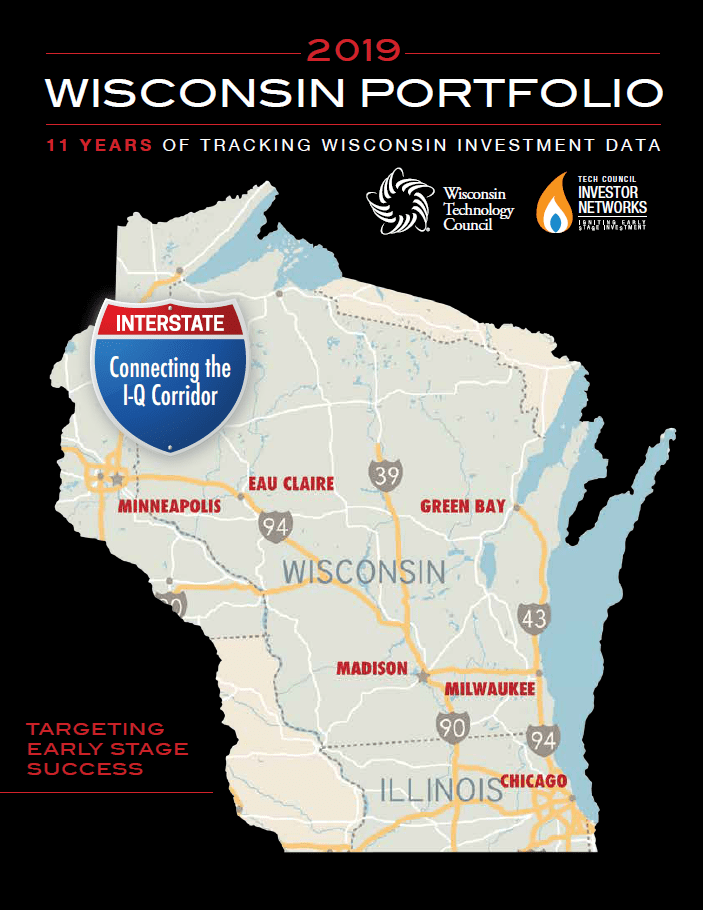By Tom Still
 MADISON, Wis. – In texting slang, “OPM” is short for “Other People’s Money.” When it comes to early stage investing in Wisconsin these days, it can also serve as an acronym for “Other People’s Money Matters.”
MADISON, Wis. – In texting slang, “OPM” is short for “Other People’s Money.” When it comes to early stage investing in Wisconsin these days, it can also serve as an acronym for “Other People’s Money Matters.”
Nearly half of the 121 angel and venture capital deals recorded in Wisconsin during the 2018 calendar year involved investors from other states or nations. Whether the money came from Chicago, Boston, New York, California or beyond, 49 percent of the deals in which investors were known involved people from outside Wisconsin’s borders.
That’s not a criticism of Wisconsin’s homegrown investors, who continue to place their faith in young companies here. Rather, it’s evidence that money from afar is finding its way into Wisconsin deals with promising technologies, products and ideas.
Most of the time, that kind of outside validation helps local companies and investors who can benefit from deeper pockets to help carry a company to the next stage.
The trend toward more out-of-state money discovering Wisconsin deals was a trend noted in the 2019 “Wisconsin Portfolio,” a publication produced annually by the Wisconsin Technology Council. The 11th annual report recorded $280.7 million in total investment, a record for Wisconsin, in 121 separate deals.
Total deals were down slightly from 2017, when 127 investments were recorded. The dollar count continued a generally upward five-year trend, however, and reflects increases in both the median and average deal sizes.
Over the five years beginning in 2014, Wisconsin early stage companies have raised $1.216 billion. There were $218.8 million in early stage investments in 2014, $209.5 million in 2015, $276.2 million in 2016 and $231 million in 2017.
Wisconsin’s average deal size in 2018 stood at an all-time high of $2.3 million while the median round size climbed back to more than $600,000. Forty-six Wisconsin companies each raised at least $1 million from investors, up from 35 companies in 2017.
Those deal sizes are growing, in part, because outside investors often represent bigger funds. It is not purely a Wisconsin phenomenon.
For reasons that range from the region’s share of U.S. economic clout to the talent produced by the region’s colleges and universities, and from Silicon Valley fatigue to lower business and living costs, more investors are discovering the Midwest.
Funds such Drive Capital, 50 South Capital, Lewis and Clark, Allos Ventures, Lightbank Fund and Revolution Ventures have planted a flag in the Midwest, often exclusively as a region, because they see the potential for deals that make money for them while producing jobs and economic activity.
Most early stage capital is still clustered on the coasts, but observers expect the Midwest share to rise due to these and other factors: 20 percent share of U.S. gross domestic product, 21 percent of Inc. 5000 headquarters, 27 percent of Fortune 500 headquarters. 31 percent of university research and development spending on engineering, 27 percent of graduating engineers and 90 percent of the 10 most attractive cities for new college graduates.
Silicon Valley is also over-heating, with people, companies and investors looking for better and less expensive places to live and work. The next wave of the internet and information technology also favors the Midwest, which remains a hub for manufacturing.
How are Midwestern states positioning themselves for this renewed interest?
Some have been aggressive about underwriting state funds, matched by private dollars, that co-invest in young companies and other funds. Michigan, Ohio, Illinois and, most recently, Indiana’s Next Level Fund, have followed that approach in the belief a rising investment tide will lift all states in the region.
Wisconsin has a toehold called the Badger Fund of Funds, which has invested in at least a dozen young companies statewide through its “recipient funds” in a handful of locations. The state of Wisconsin is a limited partner in the fund through a $25-million investment.
However, investments in funds established in other Midwest states average hundreds of millions of dollars per state and those dollars are magnets for much more in private investment. For states that have engaged in larger funds, the paybacks are significant in tax dollars, economic growth and good-paying tech jobs.
Is Wisconsin primed to step up? The latest “Wisconsin Portfolio” suggests so. What’s needed now is the political will to build upon a tech economy infrastructure that is already growing. It’s an opportunity worthy of bipartisan support.
Still is president of the Wisconsin Technology Council and can be reached at tstill@wisconsintechnologycouncil.com. To download the report: https://wisconsintechnologycouncil.com/publications/wisconsin-portfolio/


